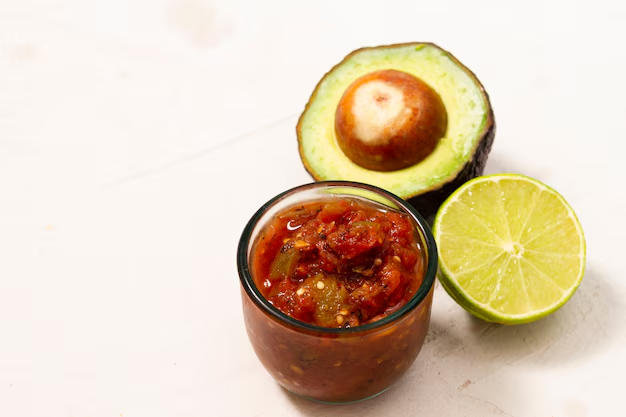Preserving Freshness: How Long Does Homemade Salsa Last in the Refrigerator?
There's nothing quite like the flavor of fresh, homemade salsa. Whether you're preparing a traditional tomato-based salsa or experimenting with unique ingredients like mango or corn, this versatile condiment can enhance a variety of dishes. But once you've crafted the perfect batch, a common question arises: How long will homemade salsa last in the refrigerator? Understanding how to store salsa properly and knowing the signs of spoilage can help ensure you enjoy your creation at its freshest. 🍅🌿
The Lifespan of Homemade Salsa
Homemade salsa generally lasts between 4 to 7 days in the refrigerator. Several factors influence this timeframe, including the ingredients used, the freshness of those ingredients, and how the salsa is stored.
Key Factors Affecting Salsa's Shelf Life
Ingredients:
- Freshness: Salsa made with fresh, high-quality ingredients will naturally last longer. Overripe or bruised tomatoes, for instance, might shorten the lifespan of your salsa.
- Acidity: Ingredients like lime juice and vinegar, commonly used in salsa, act as natural preservatives due to their acidity, potentially extending shelf life.
Storage Technique:
- Airtight Containers: Use airtight containers to minimize exposure to air, which can lead to spoilage.
- Refrigeration: Store your salsa in the refrigerator as soon as possible. Delaying refrigeration can reduce its lifespan significantly.
Environmental Factors:
- Temperature and humidity in your refrigerator can also impact the longevity of your salsa. Keep an eye on your fridge settings to ensure optimal storage conditions.
Recognizing Spoiled Salsa
Despite your best efforts, salsa can eventually spoil. Recognition is key to preventing foodborne illnesses.
Signs Your Salsa Has Gone Bad
- Off Smell: If your salsa emits a sour, unpleasant odor, it's time to toss it.
- Color Changes: A significant darkening or dullness in color can indicate spoilage.
- Texture Alterations: If your salsa becomes excessively watery or develops a slimy texture, it's past its prime.
- Mold: Any signs of mold mean immediate disposal is necessary.
Tips to Extend the Shelf Life of Homemade Salsa
To stretch the lifespan of your homemade salsa, consider these practical tips:
Storage Techniques
- Use Fresh Ingredients: Always start with the freshest ingredients possible.
- Freeze for Longevity: If you've made more salsa than you can consume in a week, consider freezing a portion. Freezing can preserve salsa for up to three months, though the texture may change slightly upon thawing.
- Avoid Double-Dipping: To prevent introducing bacteria, use clean utensils each time you serve salsa.
Creative Ways to Use Salsa Before It Spoils
Maximize the use of your homemade salsa by exploring creative culinary applications:
- Topping for Grilled Meats and Fish: Add a burst of flavor and freshness.
- Mix-In for Omelets: Enhance your breakfast with a spicy kick.
- Base for Soups and Stews: Use salsa as a base for added depth and richness.
- Salad Dressing Substitute: Toss with greens for a light and zesty dressing alternative.
Visual Summary: Salsa Storage Tips 🌟
Here's a quick-reference guide to help you maintain salsa freshness:
| Tip | Action |
|---|---|
| Use Fresh Ingredients | Start with ripe, unblemished produce for best results. |
| Store in Airtight Containers | Prevent air exposure to extend shelf life. |
| Refrigerate Promptly | Always store your salsa in the fridge soon after preparation. |
| Freeze for Longer Life | Consider freezing if consuming within a week is unlikely. |
| Avoid Cross-Contamination | Use clean utensils every time you serve salsa. |
| Pay Attention to Signs | Watch for off smells, discoloration, and texture changes. |
Refrigeration and Its Role in Food Safety
Refrigeration plays a critical role in food safety by slowing the growth of bacteria. It's essential not only for homemade salsa but for a wide array of perishable foods.
Understanding the "Danger Zone"
The "danger zone" refers to temperatures between 40°F and 140°F, where bacteria can multiply rapidly. Keeping salsa consistently below this threshold is integral to its preservation.
Preserving Salsa with Additional Techniques
Apart from traditional refrigeration, other techniques can be beneficial:
- Canning: If you wish to store salsa for extended periods, canning can be an effective method. Ensure proper sterilization and follow safe canning practices to prevent harmful bacteria growth.
- Vacuum Sealing: This method removes air before sealing, offering robust protection and extending shelf life.
Enjoying Homemade Salsa Responsibly
While the allure of homemade salsa is undeniable, enjoying it responsibly is key. By understanding storage best practices and recognizing signs of spoilage, you can savor your salsa while minimizing waste. Remember, when in doubt about the freshness of your salsa, it's safer to err on the side of caution. Preparing the perfect salsa is an art, but storing it correctly ensures your masterpiece remains delicious for days to come. 🌶️🌟
Delve into the world of salsa with confidence and creativity, making each batch not only a delight but a testament to your culinary prowess. Whether you're entertaining guests or enjoying a quiet meal, homemade salsa can be a vibrant, tasteful companion that adds zest to your dining experience.
